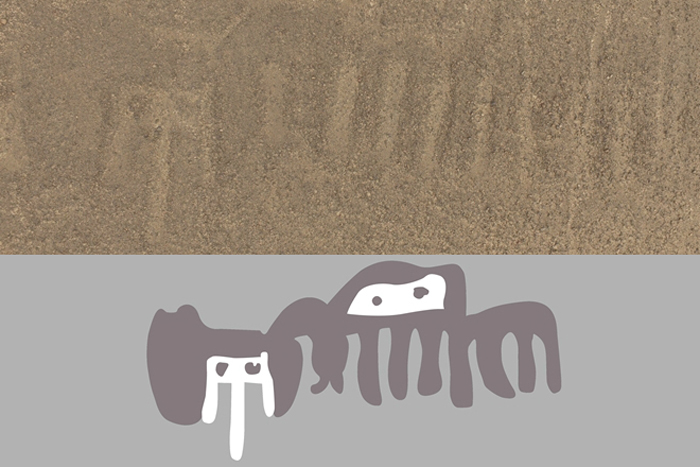100-Foot Image of Mythical Creature Discovered in Peru

A new Nazca geoglyph has been uncovered by Japanese scientists in Peru, and it could be linked to a major ceremonial center.
Measuring 98-feet long, the geoglyph is located within the central area of the Nazca pampa, a large, flat, arid region of Peru between the Andes and the coast. The line drawing is of an animal, with many legs and spotted markings, sticking out its tongue.
"It certainly represents an imaginary or mythical creature," Masato Sakai at the Yamagata University in Japan, said.
Ancient Peruvian Mystery Solved From Space
Last year a team lead by Sakai discovered dozens of new geoglyphs of animals in the same area using to 3-D scans of the ground.
This time, the researchers just spotted the new lines when walking on the Nazca plateau.
"Because the geoglyph is located on the slopes, it can easily be identified on the ground level," Sakai told Discovery News.
Get the world’s most fascinating discoveries delivered straight to your inbox.
Peru's Nazca Lines Reveal Mysterious New Animal Images
Mostly known for their massive desert images of animals and birds, the Nazca flourished in Peru between the first century B.C. and the seventh century A.D. and slid into oblivion by the time the Inca Empire rose to dominate the Andes.
The new geoglyph is estimated to date back to the Late Paracas Period (400 B.C. to 200 B.C.). The dating comes from earlier versions of the motifs previously found on the pampa, which are believed to have been created at the Late Paracas period.
The geoglyph features a different technique than most famous Nazca lines. Typical of the Late Paracas Period, the technique relies on the white ground which lies underneath the black oxidized pebbles of the pampa.
Mysterious Nazca Lines Formed Ancient Pilgrimage Route
"This new animal drawing was created by removing dark surface stones and exposing the underlying whitish ground," Sakai said. "The removed stones were then piled up to shape the animal image like a relief."
He believes the animal drawing might be linked to the vast ceremonial center of Cahuachi, which contains about 40 mounds topped with adobe structures.
"We discovered another geoglyph in 2011, not far from the newly found one," Sakai said. "It was created using the same technique and showed a pair of anthropomorphic figures in a scene of decapitation." Decapitation was a popular activity within the Nazca civilization, which was obsessed over trophy heads. They seem to have used the human heads for their ceremonial activity.
More than 50 'Nazca Lines' Found in Kazakhstan
Both geoglyphs were located on the slopes, so that they could easily be identified on the ground level.
"Between these two geoglyphs, there is an ancient path leading to the ceremonial center of Cahuachi," Sakai said.
He believes the geoglyphs were probably related to the pilgrimage to Cahuachi.
"They seem to make the path worth walking," he added.
Originally published on Discovery News.


